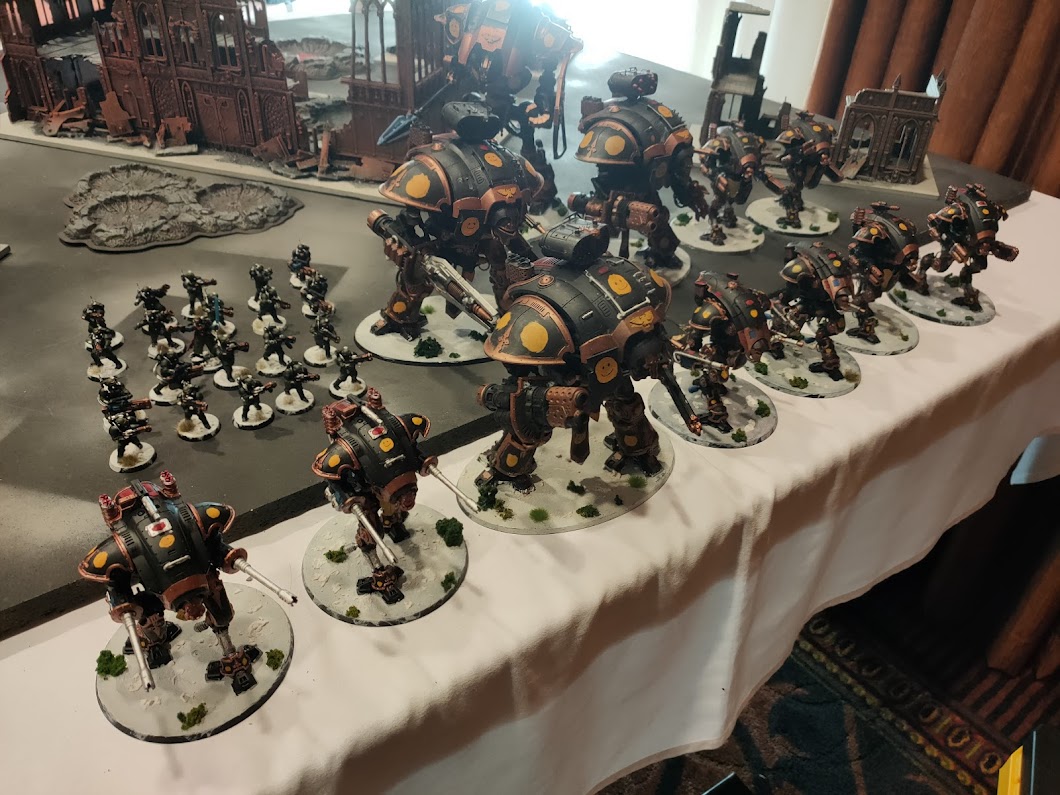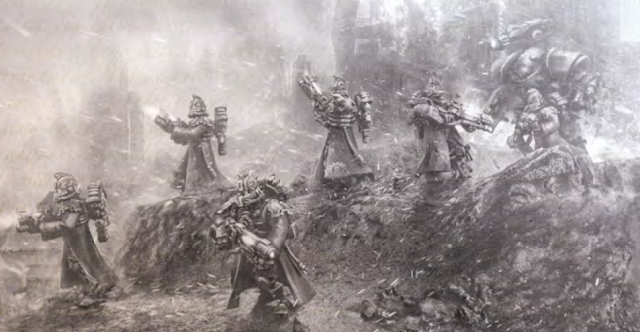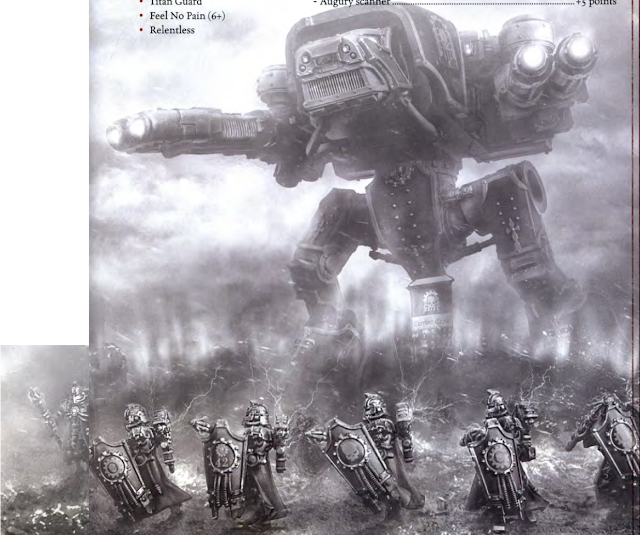About My Blog
Featured Post
Retrospective: Imperial Knights
Today, we're going to a Retrospective on...Imperial Knights! I mean, this is primarily an Imperial Knight blog, so obviously if I'm ...

Thursday, February 29, 2024
House Vyronii and the Battle for Felweather Keep
Wednesday, February 28, 2024
Leman Russ tanks for Legions Imperialis
Tuesday, February 27, 2024
More Solar Auxilia infantry and PNGtuber
Sunday, February 25, 2024
Retrospective: Titan Legions
The Titan Legions first appeared in the 1988 game, Adeptus Titanicus, and I'm sure you all know by now the old story. How, you know, to justify two identical armies fighting against each other, Games Workshop had to come up with an in-universe reason. Thus the Horus Heresy was born, a civil war that tore the Imperium into two, and explained why you basically had two identical forces fighting against each other. It helped to keep costs down so that you could just sell the same sprue twice or something. As you will see below, the sprues were divided into red and blue, so that two players can use them.
The only Titans that existed in the first edition were Warlord Titans, and they were, as you can see above, the most common class of Titan. And I love the fluff. The Chaplain going, "Look, my brothers! Heresy!" And getting his chaps to shoot at the Titan with bolters. Good luck with that. The bolt rounds obviously did nothing against the void shields, and I doubt they would have left a mark on the 2+ armor even if the void shields were down. The Warlord Titan then casually "melted" the poor Marines with a couple of salvos from his...uh, las-cannon. Got to love the old fluff, it was cheesy yet so fun.
The Reaver class Battle Titan is slightly smaller than the Warlord Titan, and has weapons on its arms and a single carapace mount. In contrast, the Warhound Scout Titan only has two weapon hard points and no carapace-mounted weapons, but is a lot faster than the other variants.
Got to love these little guys. Oh yeah, and in that same issue, they decided to add Land Raiders into Adeptus Titanicus. Like I said, wild, wild times. Also, you'll notice Paramar V is name dropped in the illustration below...and the world, as well as the Paramar system, would be expanded upon in Horus Heresy Book 3: Extermination, released in May 2014 - about 25 years after this photograph was done in the January 1998 White Dwarf 109.
By the way, this is also the same issue that added Imperial Guard as an army for the larger 28mm scale game. But that's not very relevant here, so I will talk about Imperial Guard in another article.
This would see the addition of the biggest ever Titan class, the Imperator Titan. He was pitted against 2 Mega-Gargants, but fortunately, we also have our 10 Imperial Knights (mostly Paladin class), duelling against 12 Ork Bonebreaka tanks. Unfortunately, both the Imperator Titan and Mega-Gargants were phased out of the game. Sad.
Anyway, the Warmaster Heavy Battle Titan was supposedly kept a secret by the Mechanicum until the latter days of the Horus Heresy. The first rumors of his emergence dated from the Death of Innocence upon Mars. Legio Mortis unleashed their hidden stock of Warmaster Titans upon Loyalist forces during the Schism of Mars, annihilating them. Heavily armored, allowing him to withstand barrages of artillery and Titan-grade weaponry, he is equipped with Suzerain plasma destructors capable of slaying super-heavy tanks and Titans alike, as well as shoulder weapons that would normally be mounted upon a Warhound Scout Titan.
Saturday, February 24, 2024
Painted Legions Imperialis models (1st batch)
Legions Imperialis beginnings
Thursday, February 22, 2024
Painted Armigers
Sunday, February 18, 2024
Legio Draconis
Legio Draconis was founded during the heady days of the Great Crusade. When Ryusei was welcomed back to the fold of the Imperium, the shrewd diplomacy of the Shogun, Yato Yoshinobu, negotiated directly with the Mechanicum to colonize a new Forge World within the Draconis system. The once abandoned world of Koya, the battleground of a cataclysmic war between the settlers from the Dark Age of Technology and the Men of Iron who had risen against their creators, was given over to Mechanicum Explorator fleets and survey vessels. The Tech-priests of the Cult Mechanicum exploited the opportunity to salvage and study the broken husks of automata amidst the previously irradiated wasteland of the blasted planet's cratered landscape, while House Yato - the ruling Knight house of Ryusei - saw in this the opportunity to foster close ties with the vast organization that would train their armorers and craftsmen, as well as repair aging Knights suits and manufacturing massive batches of new ones.
The majority of the Tech-priests and adepts who flocked to the newly founded Forge World - christened Draconis IV in a coldly logical and rational manner, for it was the fourth planet from the yellow sun - originated from Ryza. Principally followers of the Omnissiah Igvita, the Mechanicum sects that settled upon Draconis IV focused on fabricating forge-fanes and manufactorums dedicated to the production of plasma, be it reactors, engines or weaponry. Such was their dedication that Draconis IV was known as the second Ryza, second only to that ancient and honored Forge World in producing vast stockpiles of plasma weaponry.
Along with famed Ryzan plasma technology, renegade Magi and reckessly innovative adepts fleeing the persecution of Mars had gathered to the fledging Forge World, either to continue their experiments in secret or to seek refuge from what they perceived as hideously hidebound authority. Nonetheless, no matter the origin or faith, they pledged allegiance to Ryza and its teachings, and the Fabricator-Marshal's firm hand on the world along with strong ties with the Imperial-aligned House Yato meant that the Forge World would remain loyal to the Emperor during the outbreak of the Horus Heresy. Moreover, most did not forget the persecution they had suffered from Martian machinations and the Prefecture Magisterium under the rule of Fabricator-General Kelbor-Hal, and they were only too eager to exploit the opportunity for revenge against perceived wrongs.
Prior to the Warmaster's revelation of treachery, though, the Archmagi and their subordinate Tech-priests worked hard in establishing Draconis IV as an industrial power, benefiting from the wealth of minerals located both within the planet's crust and the immense asteroid belt that drifted along the outer edges of the Draconis system. Though they did not receive any gifts from Legio Crucius or the Titan Legions of other Forge Worlds, the Mechanicum priesthood of the newly colonized planet endeavored to resolve the problem with their ingenuity and labor. Initially unworried, for the formidable might of House Yato and the steely assurances the noble Knight household offered through a near unbreakable alliance contributed a significant portion of their military strength, they could also call upon the ceramite strength and enormous host of Legio Cybernetica cohorts and their Magi Dominus who had not only made the Forge World their base of operations, but also relied on it to construct new armies of automata. Not to mention the armored convoys of Stormblade super-heavies and Leman Russ Executioner tanks that they churned out for the Draconian Defenders Solar Auxilia and Excertus Imperialis regiments. Even so, the adepts of Draconis IV began diverting resources toward the creation of a Titan Legion of their own. Not out of necessity, but as part of their quest for knowledge, for was the next step after fabricating plasma reactors not the construction of the god-engines that fed upon the power they provided? Were the Titans not the logical succession of the Knight armors that they were already producing in mass?
So it was that the first god-engines of Legio Draconis were fashioned within the largest of forge-fanes and Titanic industries. Despite their ingenuity and the resources freely available to them, as well as ties to Ryza and Mars, the construction of god-engines is not a simple task, and the freshly founded Forge World was already spending much of those on Knight suits, battle-automata and super-heavy tanks. Even so, the few god-engines they built were slated to be shipped out almost immediately, with barely-trained and inexperienced Princeps and their Moderatii teams eager to deploy their new machines in combat.
Careful husbanding of the few god-engines available to them allowed them to slowly increase their numbers as the years of the Great Crusade flew by. Though frequently dispatched along Expeditionary fleets, notably those where noble scions of House Yato who had joined the Ordo Questoris were embedded within, they won few honors. Despite their contributions in the Rangdan Xenocides and other theaters of war, their small numbers meant they were never a notable presence, particularly compared to other Titan Legions or even their allied Knight house, who fielded countless lances of night-black Knight armors enough to cover entire continents in darkness. The princeps were often indoctrinated by the Draconian Mechanicum to be cautious and reserved, and despite their enthusiasm, they were obliged to prioritize the survival of their precious god-engines, which further contributed to their less than stellar reputation. The tiny size of Legio Draconis usually meant that a single god-engine or two would march in support of questing Knight lances, especially those belonging to House Yato or House Kanda, instead of mobilizing in maniples.
When the fires of the Horus Heresy broke out, the stalwart god-engines of House Draconis would stand alongside the firmly Loyalist House Yato, marching in support of the smaller Knight armors to throw back ravening hordes of Traitors and decimate whole armor formations of treacherous Legionnaires and Excertus alike. While outmatched and outnumbered by enemy Titan Legions, the Dark Dragons would provide fire support from a distance for their allied Knight houses, who would close in while the foe is distracted and engage the opposing god-engines in close range, felling them with reaper chainswords, shock lances, thermal cannons and exotic weaponry bestowed upon them by the innovative Magi of Draconis IV. They stood alongside Legio Crucius when Ryza called for aid, answering the requests of assistance from their grandparent Forge World and repelling the Traitors with plasma fury.
 |
| LEGIO DRACONIS WARLORD BATTLE TITAN KAGUTSUCHI |
MATERIEL STRENGTH
At the onset of the Horus Heresy, Legio Draconis was still pretty much in its infancy, and the century or so of their existence meant that they were never able to amass god-engines in any large number. Furthermore, despite the prodigious skills and incredible resources of Draconis IV, as well as its ties to Ryza, the Draconian Mechanicum had focused on constructing the larger Titan classes and eschewed Scout Titans entirely, reasoning that the huge numbers of Knight armors from both House Yato and House Kanda would function in an identical role. As such, they devoted their labors into fabricating mainly Warlord and Warmaster class Titans, most of whom were equipped with the plasma and volkite weaponry that Draconis IV (and by extension, Ryza, who counted the new Forge World among its empire) was famed for. The sunfury plasma annihilator and plasma destructors are a staple, as are the volkite destructors that burst apart enemy void shields so that the princeps can target the vulnerable god-engine within with the concentrated fury of a star.
 |
| LEGIO DRACONIS WARMASTER HEAVY BATTLE TITAN AMATERASU |
As befitting a radical Forge World, several Warlord Titans were also equipped with conversion beam extirpators, which often complemented the longer-ranged Belicosa volcano cannons as opposed to the plasma annihilator or the volkite destructor, for optimal range efficiency.
When Draconis IV declared for the Emperor, along with the fiercely loyal House Yato, Legio Draconis possessed barely thirty god-engines, most of them comprising of the Warlord class, with a handful of Warmaster class Titans. The sole exception was a single Imperator Titan, Izanagi, who is equipped with an immense plasma annihilator and stands proudly as the Forge World's most potent defender during the dark times. Many of these god-engines fell in defense of the Imperium, the attrition whittling away at Legio Draconis's already small numbers until they stood at the brink of extinction. Nonetheless, so long as the Magi of Draconis IV remain, they will ensure the preservation and restoration of the Dark Dragons, so that the valiant Titan Legion can continue to fight throughout the millennia ahead.

















































